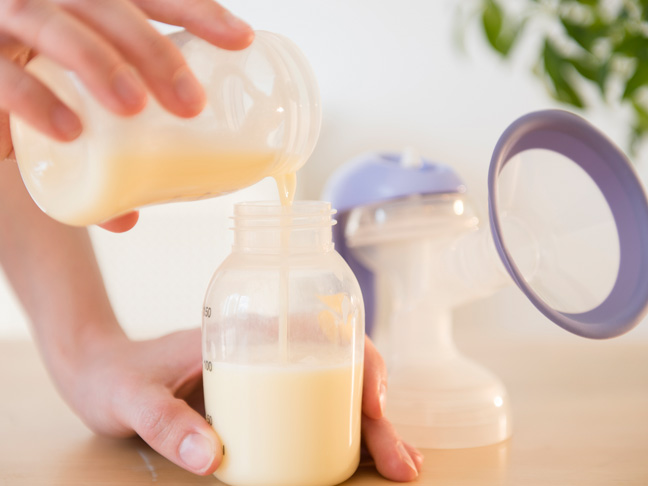Breast milk is pretty great. In fact, according to the American Academy of Pediatrics, breastfeeding reduces the risk of disease and infection in babies, decreases the likelihood of childhood obesity, promotes bonding with your baby, and reduces your risk of breast and ovarian cancer. But, what’s in breast milk exactly? What’s the difference between foremilk and hindmilk? How long can it be stored? Why isn’t breast milk pure white? See, while we’ve heard a lot about the benefits of breastfeeding, there’s plenty that most of us don’t know about breast milk. So, I spoke with Freda Rosenfeld, a board certified lactation consultant in New York City, for answers.
What’s in breast milk?
Breast milk contains proteins — whey, casein, lactoferrin, secretory IgA, Lysozyme, and bifidus factor — which aid digestion, promote healthy intestinal flora, and grow beneficial bacteria while protecting against harmful viruses and bacteria; fats, which are beneficial for brain development, developing the nervous system, and calorie building; vitamins A, C, D, E, K (which is why many nursing moms continue with their prenatal vitamins); and the carbohydrate lactose, which decreases unhealthy bacteria in order to improve calcium absorption, as well as providing beneficial calories.
What’s the difference between foremilk and hindmilk?
Foremilk is the breast milk that your baby receives at the beginning of a feeding; hindmilk is the higher fat milk that your baby receives at the end of a feeding.
Why isn’t breast milk pure white?
The color of breast milk may change due to the amount of foremilk or hindmilk it contains. Foremilk may look thinner and more blueish because it has less fat and more sugar than milk produced after the milk lets down. When your milk looks more yellowish, that is due to the hindmilk, which comes after the foremilk and appears thicker and creamier.
Why does some breast milk look creamy, while other breast milk looks watery?
Breast milk contains fat, which will determine its stickiness or creaminess. You may notice that your breast milk is thinner at the beginning of a feed (foremilk), and gradually becomes thicker/fattier (hindmilk). The fat globules tend to stick together, collecting toward the back of the breast as your baby feeds, only coming to the front of the nipple toward the end of the feed. It is important to let your baby nurse fully on one breast before switching, to be sure she is getting all the goodness of the hindmilk.
What does breast milk taste like?
Although the flavor of breast milk can change from woman to woman and be affected by what you have eaten, it generally tastes sweet, thanks to lactose, an organic compound that naturally produces glucose in milk.
What should you eat as a breastfeeding mom?
Nursing moms should remember to drink plenty of water, and eat a well-rounded diet that includes plenty of steamed veggies, grains, animal and/or plant protein, and good fats (think nuts and seeds). Keep in mind that some specific foods can affect how your baby feels. “I encourage people to avoid raw veggies, for example, because the fiber is so strong,” says Rosenfeld. “Cook veggies instead.” If your baby has blood in her diaper (a sign of a cow’s milk allergy) or is excessively gassy, consult your pediatrician.
How long can breast milk be stored?
Pumped breastmilk keeps at room temperature for up to six hours. In an insulated bag, it can last up to a day. Refrigerated milk has a three- to eight-day lifespan (but only 24 hours if it has been thawed). Milk stored in a deep freezer can last up to a year, however, the Mayo Clinic recommends it be consumed within six months of freezing. Because milk is not pasteurized or homogenized, and can therefore go bad faster, the best way to store it is to perform a “mini homogenization.” Rosenfeld explains that by very gently swirling the milk before storing it in an airtight bag and freezing it, the milk won’t separate and will last longer as a result.
Can you drink alcohol while breastfeeding?
According to guidelines set forth by La Leche League, breastfeeding moms should not consume more than one alcoholic drink a day. Additionally, it takes two to three hours for alcohol to leave a woman’s bloodstream, so it’s important to time your baby’s feeding accordingly. “I do not recommend hard liquor, but beer and wine, after your baby is a week or two old, is fine,” adds Rosenfeld.
More for Breastfeeding Moms:
